North Africa
| North Africa | |
|---|---|
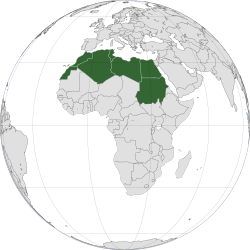 | |
| Countries |
Other territories (3)
Partially recognized states (1) |
| Time zones | UTC+00:00 UTC+01:00 UTC+02:00 |

North Africa (sometimes Northern Africa) is a region encompassing the northern portion of the African continent. There is no singularly accepted scope for the region, and it is sometimes defined as stretching from the Atlantic shores of the Western Sahara in the west, to Egypt and Sudan's Red Sea coast in the east.[1]
The most common definition for the region's boundaries includes Algeria, Egypt, Libya, Morocco, Tunisia, and Western Sahara, the territory disputed between Morocco and the partially recognized Sahrawi Arab Democratic Republic. The United Nations' definition includes all these countries as well as the Sudan.[4] The African Union defines the region similarly, only differing from the UN in excluding the Sudan.[5] The Sahel, south of the Sahara Desert, can be considered as the southern boundary of North Africa.[6][7][8] North Africa includes the Spanish cities of Ceuta and Melilla, and the plazas de soberanía. It can also be considered to include Malta, as well as other Italian, Portuguese, and Spanish regions such as Lampedusa and Lampione, Madeira, and the Canary Islands, which are all closer or as close to the African continent than Europe.
Northwest Africa has been inhabited by Berbers since the beginning of recorded history, while the eastern part of North Africa has been home to the Egyptians.[9] In the seventh and eighth centuries, Arabs from the Arabian Peninsula swept across the region during the early Muslim conquests. The Arab migrations to the Maghreb began immediately after, which started a long process of Islamization and Arabization that has defined the cultural landscape of North Africa ever since. Many but not all Berbers and Egyptians gradually merged into Arab-Islamic culture.
The countries and people of North Africa share a large amount of their genetic, ethnic, cultural and linguistic identity and influence with the Middle East/West Asia, a process that began with the Neolithic Revolution c. 10,000 BC and pre Dynastic Egypt. The countries of North Africa are also a major part of the Arab world. The Islamic and Arab influence in North Africa has remained dominant ever since, with the region being major part of the Muslim world. North Africa is associated with the Middle East in the realm of geopolitics to form the Middle East-North Africa region.[10]
Geography
[edit]

North Africa has three main geographic features: the Sahara desert in the south, the Atlas Mountains in the west, and the Nile River and delta in the east. The Atlas Mountains extend across much of northern Algeria, Morocco, and Tunisia. These mountains are part of the fold mountain system that also runs through much of Southern Europe. They recede to the south and east, becoming a steppe landscape before meeting the Sahara desert, which covers more than 75 percent of the region. The tallest peaks are in the High Atlas range in south-central Morocco, which has many snow-capped peaks.
South of the Atlas Mountains is the dry and barren expanse of the Sahara desert, the largest sand desert in the world.[11] In places the desert is cut by irregular watercourses called wadis—streams that flow only after rainfall but are usually dry. The Sahara's major landforms include ergs, large seas of sand that sometimes form into huge dunes; the hammada, a level rocky plateau without soil or sand; and the reg, a desert pavement. The Sahara covers the southern part of Algeria, Morocco and Tunisia, and most of Libya. Only two regions of Libya are outside the desert: Tripolitania in the northwest and Cyrenaica in the northeast. Most of Egypt is also desert, with the exception of the Nile River and the irrigated land along its banks. The Nile Valley forms a narrow fertile thread that runs along the length of the country.
Sheltered valleys in the Atlas Mountains, the Nile Valley and Delta, and the Mediterranean coast are the main sources of fertile farming land. A wide variety of valuable crops including cereals, rice and cotton, and woods such as cedar and cork, are grown. Typical Mediterranean crops, such as olives, figs, dates and citrus fruits, also thrive in these areas. The Nile Valley is particularly fertile and most of Egypt lives close to the river. Elsewhere, irrigation is essential to improve crop yields on the desert margins.
Demographics
[edit]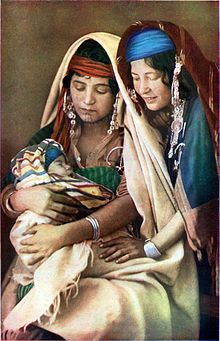
Ethnic groups
[edit]The inhabitants of North Africa are roughly divided in a manner corresponding to the principal geographic regions of North Africa: the Maghreb, the Nile valley, and the Sahel. The countries making up North Africa all have Modern Standard Arabic as their official language. Additionally, Algeria and Morocco recognize Berber as a second official language after Arabic. French also serves as an administrative language in Algeria, Morocco and Tunisia. The most spoken dialects are Maghrebi Arabic, a form of ancient Arabic dating back from the 8th century AD, and Egyptian Arabic. The largest and most numerous ethnic group in North Africa are the Arabs.[12] In Algeria and Morocco, Berbers are the second largest ethnic group after the Arab majority. Arabs constitute 70%[13] to 80%[14] of the population of Algeria, 92%[15]97%[16] of Libya, 67%[17] to 70%[18] of Morocco and 98%[19] of Tunisia's population. The Berbers comprise 20%[20] of Algeria, 10%[21] of Libya, 35%[22] of Morocco and 1%[23] of Tunisia's population. The region is predominantly Muslim with a Jewish minority in Morocco and Tunisia,[24] and significant Christian minority—the Copts—in Egypt, Algeria,[25][26] Morocco,[27] Libya,[28] and Tunisia.[29] In 2001, the number of Christians in North Africa was estimated at 9 million, the majority of whom live in Egypt, with the remainder live in Maghreb countries.[30][31]
The inhabitants of the Spanish Canary Islands are of mixed Spanish and North African Berber ancestry, and the people of Malta are of primarily Southern Italian/Sicilian, as well as, to a lesser extent, North African and Middle Eastern ancestry[32][33][34] and speak a derivative of Arabic. However, these areas are not generally considered part of North Africa, but rather Southern Europe, due to their proximity to mainland Europe and their European-based cultures and religion.
Historic movements
[edit]The Maghreb or western North Africa on the whole is believed to have been inhabited by Berbers and their ancestors since at least 10,000 B.C.,[35] while the eastern part of North Africa or the Nile Valley has mainly been home to the Egyptians and Nubians. Ancient Egyptians record extensive contact in their Western desert with people that appear to have been Berber or proto-Berber. As the Tassili n'Ajjer and other rock art findings in the Sahara have shown, the Sahara also hosted various populations before its rapid desertification in 3500 B.C and even today continues to host small populations of nomadic trans-Saharan peoples. Laboratory examination of the Uan Muhuggiag child mummy and Tin Hanakaten child, suggested that the Central Saharan peoples from the Epipaleolithic, Mesolithic, and Pastoral periods possessed dark skin complexions.[36] The archaeological evidence from the Holocene period has shown that Nilo-Saharan speaking groups had populated the central and southern Sahara before the influx of Berber and Arabic speakers, around 1500 years ago, who now largely populate the Sahara in the modern era.[37]

After migrating to North Africa in the 1st millennium BC, Semitic Phoenician settlers from the Levant established over 300 coastal colonies throughout the region and built a powerful empire that controlled most of the region from the 8th century BC until the middle of the 2nd century BC.[38]
Several waves of Arab migrations to the Maghreb began in the 7th century, including the migration of the Banu Hilal and the Banu Sulaym westward into the Maghreb in the eleventh century, which introduced Arab culture and language to the countryside. Historians mark their movement as a critical moment in the Arabization of North Africa.[39] As Arab nomads spread, the territories of the local Berber tribes were moved and shrank. The Zenata were pushed to the west and the Kabyles were pushed to the north. The Berbers took refuge in the mountains whereas the plains were Arabized.[40] This heavily shifted the demographics of the Maghreb.
Genetic history
[edit]DNA studies of Iberomaurusian peoples at Taforalt, Morocco dating to around 15,000 years ago have found them to have a distinctive Maghrebi ancestry formed from a mixture of Near Eastern and African ancestry, which is still found as a part of the genome of modern Northwest Africans.[41] Later during the Neolithic, from around 7,500 years ago onwards, there was a migration into Northwest Africa of European Neolithic Farmers from the Iberian Peninsula (who had originated in Anatolia several thousand years prior), as well as pastoralists from the Levant, both of whom also significantly contributed to the ancestry of modern Northwest Africans.[42] The proto-Berber tribes evolved from these prehistoric communities during the late Bronze- and early Iron ages.[43]
Culture
[edit]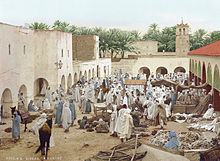

The majority of the people of the Maghreb and the Sahara regions speak varieties of Arabic and almost exclusively follow Islam. The Arabic and Berber languages are distantly related, both being members of the Afroasiatic language family. The Tuareg Berber languages are notably more conservative[clarification needed] than those of the coastal cities.
Over the years, Berbers have been influenced by contact with other cultures: Egyptians, Greeks, Punic people, Romans, Vandals, Arabs, Europeans, and Africans. The cultures of the Maghreb and the Sahara therefore combines Arab, indigenous Berber and African elements. In the Sahara, the distinction between sedentary oasis inhabitants and nomadic Bedouin Arabs and Tuaregs is particularly marked.
Egyptians over the centuries have shifted their language from Egyptian (in its late form, varieties of Coptic) to modern Egyptian Arabic while retaining a sense of national identity that has historically set them apart from other people in the region. Most Egyptians are Sunni Muslim, although there is a significant minority of Coptic Christians. The Copts are the largest Christian denomination in the Middle East and North Africa.[44]
The Maghreb formerly had a significant Jewish population, almost all of whom emigrated to France or Israel when the North African nations gained independence. Prior to the modern establishment of Israel, there were about 500,000 Jews in Northern Africa,[45] including both Sephardi Jews (refugees from Spain, France and Portugal from the Renaissance era) as well as indigenous Mizrahi Jews. Today, less than 3,000 remain in the region, almost all in Morocco and Tunisia,[46] and are mostly part of a French-speaking urban elite. (See Jewish exodus from Arab and Muslim countries.)
History
[edit]Prehistory
[edit]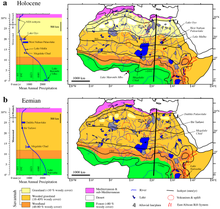
Due to the recent African origin of modern humans, the history of Prehistoric North Africa is important to the understanding of pre-hominid and early modern human history in Africa. Some researchers have postulated that North Africa rather than East Africa served as the exit point for the modern humans who first trekked out of the continent in the Out of Africa migration.[47][48][49]
The earliest inhabitants of central North Africa have left behind significant remains: early remnants of hominid occupation in North Africa, for example, were found in Ain el Hanech, near Saïda (c. 200,000 BCE); in fact, more recent investigations have found signs of Oldowan technology there, and indicate a date of up to 1.8 million BCE.[50]
Recent finds in Jebel Irhoud in Morocco have been found to contain some of the oldest Homo sapiens remains; This suggests that, rather than arising only in East Africa around 200,000 years ago, early Homo sapiens may already have been present across the length of Africa 100,000 years earlier. According to study author Jean-Jacques Hublin, "The idea is that early Homo sapiens dispersed around the continent and elements of human modernity appeared in different places, and so different parts of Africa contributed to the emergence of what we call modern humans today."[51] Early humans may have comprised a large, interbreeding population dispersed across Africa whose spread was facilitated by a wetter climate that created a "green Sahara", around 330,000 to 300,000 years ago. The rise of modern humans may thus have taken place on a continental scale rather than being confined to a particular corner of Africa.[52] In September 2019, scientists reported the computerized determination, based on 260 CT scans, of a virtual skull shape of the last common human ancestor to modern humans/H. sapiens, representative of the earliest modern humans, and suggested that modern humans arose between 260,000 and 350,000 years ago through a merging of populations in East and Southern Africa.[53][54]
The cave paintings found at Tassili n'Ajjer, north of Tamanrasset, Algeria, and at other locations depict vibrant and vivid scenes of everyday life in central North Africa during the Neolithic Subpluvial period (about 8000 to 4000 BCE). Some parts of North Africa began to participate in the Neolithic revolution in the 6th millennium BCE, just before the rapid desertification of the Sahara around 3500 B.C. largely due to a tilt in the Earth's orbit.[55] It was during this period that domesticated plants and animals were introduced in the region, spreading from the north and east to the southwest.[56] There has been an inferred connection between areas of rapid drying and the introduction of livestock in which the natural (orbital) aridification was amplified by the spread of shrubs and open land due to grazing.[57] Nevertheless, changes in northern Africa's ecology after 3500 BCE provided the backdrop for the formation of dynastic civilizations and the construction of monumental architecture such as the Pyramids of Giza.[58]
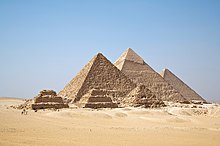
Archaeological evidence has attested that population settlements occurred in Nubia as early as the Late Pleistocene era and from the 5th millennium BC onwards, whereas there is "no or scanty evidence" of human presence in the Egyptian Nile Valley during these periods, which may be due to problems in site preservation.[59] Several scholars have argued that the African origins of the Egyptian civilisation derived from pastoral communities which emerged in both the Egyptian and Sudanese regions of the Nile Valley in the fifth millennium BCE.[60][61]
When Egypt entered the Bronze Age,[62] the Maghreb remained focused on small-scale subsistence in small, highly mobile groups.[63] Some Phoenician and Greek colonies were established along the Mediterranean coast during the 7th century BCE.
Antiquity and ancient Rome
[edit]

The most notable nations of antiquity in western North Africa are Carthage, Numidia and Mauretania. The Phoenicians colonized much of North Africa including Carthage and parts of present-day Morocco (including Chellah, Essaouira and Volubilis[64]). The Carthaginians were of Phoenician origin, with the Roman myth of their origin being that Dido, a Phoenician princess, was granted land by a local ruler based on how much land she could cover with a piece of cowhide. She ingeniously devised a method to extend the cowhide to a high proportion, thus gaining a large territory. She was also rejected by the Trojan prince Aeneas according to Virgil, thus creating a historical enmity between Carthage and Rome, as Aeneas would eventually lay the foundations for Rome. Ancient Carthage was a commercial power and had a strong navy, but relied on mercenaries for land soldiers. The Carthaginians developed an empire in the Iberian Peninsula, Malta, Sardinia, Corsica and northwest Sicily, the latter being the cause of First Punic War with the Romans.
Over a hundred years and more, all Carthaginian territory was eventually conquered by the Romans, resulting in the Carthaginian North African territories becoming the Roman province of Africa in 146 B.C.[65] This led to tension and eventually conflict between Numidia and Rome. The Numidian wars are notable for launching the careers of both Gaius Marius, and Sulla, and stretching the constitutional burden of the Roman republic as Marius required a professional army, something previously contrary to Roman values, to overcome the talented military leader Jugurtha.[66] Kingdom of Mauretania remained independent until being annexed to the Roman Empire by Emperor Claudius in 42 AD.
North Africa remained a part of the Roman Empire, producing notable citizens, including Augustine of Hippo, until incompetent leadership from Roman commanders in the early fifth century allowed the Germanic peoples, the Vandals, to cross the Strait of Gibraltar, whereupon they overcame the fickle Roman defense. The loss of North Africa is considered a pinnacle point in the fall of the Western Roman Empire as Africa had previously been an important grain province that maintained Roman prosperity despite the barbarian incursions, and the wealth required to create new armies. The issue of regaining North Africa became paramount to the Western Empire, but was frustrated by Vandal victories. The focus of Roman energy had to be on the emerging threat of the Huns. In 468 AD, the Romans made one last serious attempt to invade North Africa but were repelled. This perhaps marks the point of terminal decline for the Western Roman Empire.
The last Roman emperor was deposed in 476 by the Heruli general Odoacer. Trade routes between Europe and North Africa remained intact until the coming of Islam. Some Berbers were members of the Early African Church (but evolved their own Donatist doctrine),[67] some were Berber Jews, and some adhered to traditional Berber religion. African pope Victor I served during the reign of Roman emperor Septimius Severus. Furthermore, during the rule of the Romans, Byzantines, Vandals, Ottomans and Carthaginians the Kabyle people were the only or one of the few in North Africa who remained independent.[68][69][70][71]
The Kabyle people were incredibly resistible so much so that even during the Arab conquest of North Africa they still had control and possession over their mountains.[72][73]
Arab conquest to modern times
[edit]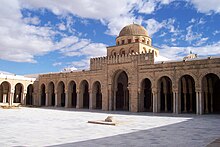
The early Muslim conquests included North Africa by 640. By 700, most of North Africa had come under Muslim rule. Indigenous Berbers subsequently started to form their own polities in response in places such as Fez and Sijilmasa. In the eleventh century, a reformist movement made up of members that called themselves the Almoravid dynasty expanded south into Sub-Saharan Africa.
North Africa's populous and flourishing civilization collapsed after exhausting its resources in internal fighting and suffering devastation from the invasion of the Banu Sulaym and Banu Hilal. Ibn Khaldun noted that the lands ravaged by Banu Hilal invaders had become completely arid desert.[75]
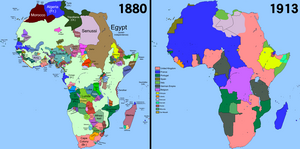
After the Middle Ages much of the area was loosely under the control of the Ottoman Empire. The Barbary pirates operated from the largely independent Barbary states located on the coast of North Africa. The Spanish Empire conquered several coastal cities between the 16th and 18th centuries. After the 19th century, the imperial and colonial presence of France, the United Kingdom, Spain and Italy left the entirety of the region under one form of European occupation.
In World War II from 1940 to 1943 the area was the setting for the North African Campaign. During the 1950s and 1960s all of the North African states gained independence. There remains a dispute over Western Sahara between Morocco and the Algerian-backed Polisario Front.
The wider protest movement known as the Arab Spring began with revolutions in Tunisia and Egypt which ultimately led to the overthrow of their governments, as well as civil war in Libya. Large protests also occurred in Algeria and Morocco to a lesser extent. Many hundreds died in the uprisings.[76]
Country statistics
[edit]| Countries and territories | List of countries and dependencies by area (km2) |
List of countries and dependencies by population | List of countries and dependencies by population density (per km2) |
Capital | List of countries by GDP (nominal) (US$ billions) |
List of countries by GDP (nominal) per capita (US$) |
Currency | Government | Official languages |
|---|---|---|---|---|---|---|---|---|---|
| 2,381,741 | 45,973,000 | 19.30 | Algiers | $224.107 | $4,874.706 | Algerian dinar | Presidential republic | Arabic and Berber (both official), French is commonly used | |
| 1,010,408 | 110,990,103 | 105.41 | Cairo | $398.397 | $3,770.133 | Egyptian pound | Semi-presidential republic | Arabic | |
| 1,759,540 | 6,845,000 | 3.89 | Tripoli | $40.194 | $5,872.222 | Libyan dinar | United Nations Interim Democratic provisional authority | Arabic | |
| 446,550 (undisputed), ~710,881 (claimed) | 37,022,000 | 82.91 | Rabat | $147.343 | $3,979.871 | Moroccan dirham | Constitutional monarchy | Arabic and Berber (both official), French is commonly used | |
| 1,886,068 | 50,467,278 | 21.3 | Khartoum | $25.569 | $533.845 | Sudanese pound | Federal republic under a military junta | Arabic and English (both official) | |
| 163,610 | 12,235,000 | 74.78 | Tunis | $51.271 | $4,190.603 | Tunisian dinar | Parliamentary republic | Arabic, French is commonly used. | |
| Western Sahara / |
266,000 (total land area, control is split between Morocco and the SADR) | 576,000 | 2.17 | disputed | disputed | disputed | disputed | disputed | Disputed: commonly Arabic and French (Moroccan zone); commonly Arabic and Spanish (SADR zone) |
Architecture
[edit]Further information in the sections of Architecture of Africa:
- Prehistoric North African Architecture
- Ancient North African Architecture
- Medieval North African Architecture
Science and technology
[edit]Further information in the sections of History of science and technology in Africa:
See also
[edit]- Culture of Egypt
- Demographics of the Middle East and North Africa
- European Digital Archive on Soil Maps of the World
- List of modern conflicts in North Africa
- List of Roman Latin poets and writers from North Africa
References
[edit]- ^ a b Brett, Michael. "Definition: North Africa (region, Africa)". Encyclopedia Britannica. Retrieved 9 September 2021.
- ^ Mattar, Philip (1 June 2004). Encyclopedia of the Modern Middle East and North Africa. Macmillan Reference USA. ISBN 9780028657691.
- ^ De facto government of parts of Western Sahara, claimant to the whole area).
- ^ "UNSD — Methodology". United Nations Statistics Division. Archived from the original on 16 January 2023.
- ^ "The Assembly – African Union". African Union. Archived from the original on 29 November 2018.
- ^ es-Sadi, Abderrahman (1898). Tarikh es soudan (in Arabic). Paris E. Leroux.
- ^ Andrew, McGregor (2001). "The Circassian Qubbas of Abbas Avenue, Khartoum: Governors and Soldiers in 19th Century Sudan" (PDF). Nordic Journal of African Studies. Archived from the original (PDF) on 15 February 2019. Retrieved 25 October 2018.
- ^ Berglee, Royal (17 June 2016). "North Africa and the African Transition Zone". World Regional Geography. Archived from the original on 1 December 2022.
- ^ National Geographic's DNA Analysis Concludes that Egyptians are Only 17% Arab, CairoScene, 16 January 2017
- ^ Güney, Aylın; Gökcan, Fulya (February 2012). "The 'Greater Middle East' as a 'Modern' Geopolitical Imagination in American Foreign Policy". Geopolitics. 15: 22–38. doi:10.1080/14650040903420370.
- ^ "Largest Desert in the World". Retrieved 30 December 2011.
- ^ Group, The Diagram (26 November 2013). Encyclopedia of African Peoples. Routledge. ISBN 978-1-135-96341-5.
{{cite book}}:|last=has generic name (help) - ^ The Report: Algeria 2007. Oxford Business Group. 2007. ISBN 978-1-902339-70-2. Archived from the original on 10 April 2023. Retrieved 30 January 2023.
- ^ Laaredj-Campbell, Anne (10 December 2015). Changing Female Literacy Practices in Algeria: Empirical Study on Cultural Construction of Gender and Empowerment. Springer. ISBN 978-3-658-11633-0. Archived from the original on 26 March 2023. Retrieved 30 January 2023.
- ^ Yakan, Mohamad (30 November 2017). Almanac of African Peoples and Nations. Routledge. ISBN 978-1-351-28930-6.
- ^ Malcolm, Peter; Losleben, Elizabeth (2004). Libya. Marshall Cavendish. ISBN 978-0-7614-1702-6. Archived from the original on 10 April 2023. Retrieved 30 January 2023.
- ^ The Report: Morocco 2012. Oxford Business Group. 2012. ISBN 978-1-907065-54-5. Archived from the original on 7 March 2023. Retrieved 30 January 2023.
- ^ Son, George Philip &; Press, Oxford University (26 December 2002). Encyclopedic World Atlas. Oxford University Press, USA. ISBN 978-0-19-521920-3.
- ^ "Tunisia", The World Factbook, Central Intelligence Agency, 2 December 2022, archived from the original on 10 January 2021, retrieved 12 December 2022
- ^ Laaredj-Campbell, Anne (10 December 2015). Changing Female Literacy Practices in Algeria: Empirical Study on Cultural Construction of Gender and Empowerment. Springer. ISBN 978-3-658-11633-0. Archived from the original on 26 March 2023. Retrieved 30 January 2023.
- ^ Zurutuza, Karlos. "Berbers fear ethnic conflict". Al Jazeera. Archived from the original on 29 January 2023. Retrieved 12 December 2022.
- ^ Danver, Steven L. (10 March 2015). Native Peoples of the World: An Encyclopedia of Groups, Cultures and Contemporary Issues. Routledge. ISBN 978-1-317-46400-6. Archived from the original on 15 March 2023. Retrieved 30 January 2023.
- ^ "Q&A: The Berbers". 12 March 2004. Archived from the original on 12 January 2018. Retrieved 12 December 2022.
- ^ Rosenberg, Jerry M. (28 September 2009). The Rebirth of the Middle East. Hamilton Books. ISBN 978-0-7618-4846-2.
- ^ * (in French) Sadek Lekdja, Christianity in Kabylie, Radio France Internationale, 7 mai 2001 Archived 18 October 2017 at the Wayback Machine
- ^ P S Rowe, Paul (2018). Routledge Handbook of Minorities in the Middle East. Routledge. p. 133. ISBN 978-1-317-23379-4.
- ^ "Refworld – Morocco: General situation of Muslims who converted to Christianity, and specifically those who converted to Catholicism; their treatment by Islamists and the authorities, including state protection (2008–2011)". Refworld.org.
- ^ Morgan, Jason; Falola, Toyin; Oyeniyi, Bukola Adeyemi (2012). Culture and Customs of Libya. ABC-CLIO. p. 40. ISBN 978-0-313-37860-7.
- ^ Fahlbusch, Erwin (2003). The Encyclopedia of Christianity: J-O. Wm. B. Eerdmans Publishing. ISBN 978-0-8028-2415-8.
- ^ Juang, Richard M.; Morrissette, Noelle (2008). Africa and the Americas [3 Volumes]: Culture, Politics, and History. UK: Bloomsbury Academic. pp. 929–930. ISBN 978-0-521-88952-0.
- ^ Juergensmeyer, Mark (2008). The Oxford Handbook of Global Religions. Oxford: Oxford University Press. p. 317. ISBN 978-0-19-976764-9.
- ^ Genetic Origin of Contemporary Maltese People. 5 August 2007.
Repopulation is likely to have occurred by a clan or clans (possibly of Arab or Arab-like speaking people) from neighbouring Sicily and Calabria. Possibly, they could have mixed with minute numbers of residual inhabitants, with a constant input of immigrants from neighbouring countries and later, even from afar. There seems to be little input from North Africa.
- ^ Geoffrey Hull, The Malta Language Question: A Case Study in Cultural Imperialism, Valletta: Said International, 1993, pp. 317–330. Scientific etymologies of the longest-established Maltese family names are given in Geoffrey Hull, "The Oldest Maltese Surnames: A Window on Sicily's Medieval History", in Claudia Karagoz and Giovanna Summerfield (eds), Sicily and the Mediterranean: Migration, Exchange, Reinvention, New York: Palgrave Macmillan, 2015, pp. 78–108; "Late Medieval Maltese Surnames of Arabic and Greek Origin", Symposia Melitensia No. 11 (2015), pp. 129–143
- ^ Genetic Origin of Contemporary Maltese People. 5 August 2007.
Together with colleagues from other institutions across the Mediterranean and in collaboration with the group led by David Goldstein at the University College, London, we have shown that the contemporary males of Malta most likely originated from Southern Italy, including Sicily and up to Calabria. There is a minuscule amount of input from the Eastern Mediterranean with genetic affinity to Christian Lebanon....We documented clustering of the Maltese markers with those of Sicilians and Calabrians. The study is published in the Annals of Human Genetics by C. Capelli, N. Redhead, N. Novelletto, L. Terrenato, P. Malaspina, Z. Poulli, G. Lefranc, A. Megarbane, V. Delague, V. Romano, F. Cali, V.F. Pascali, M. Fellous, A.E. Felice, and D.B. Goldstein; "Population Structure in the Mediterranean Basin; A Y Chromosome Perspective", AHG, 69, 1–20, 2005..
- ^ Ilahine, Hsain (2006). Historical Dictionary of the Berbers (Imazighen). Historical Dictionaries of Peoples and Cultures. Scarecrow Press. p. 112. ISBN 0-8108-6490-8.
- ^ Soukopova, Jitka (16 January 2013). Round Heads: The Earliest Rock Paintings in the Sahara. Cambridge Scholars Publishing. pp. 19–24. ISBN 978-1-4438-4579-3.
- ^ Drake, Nick A.; Blench, Roger M.; Armitage, Simon J.; Bristow, Charlie S.; White, Kevin H. (11 January 2011). "Ancient watercourses and biogeography of the Sahara explain the peopling of the desert". Proceedings of the National Academy of Sciences of the United States of America. 108 (2): 458–462. Bibcode:2011PNAS..108..458D. doi:10.1073/pnas.1012231108. ISSN 1091-6490. PMC 3021035. PMID 21187416.
- ^ Woolmer, Mark (30 April 2017). A Short History of the Phoenicians. Bloomsbury Publishing. p. 201. ISBN 978-1-78672-217-1.
- ^ Anthony Appiah; Henry Louis Gates (2005). Africana: The Encyclopedia of the African and African American Experience. Oxford University Press. p. 360. ISBN 978-0-19-517055-9.
- ^ Farida, Benouis; Houria, Chérid; Lakhdar, Drias; Amine, Semar. An Architecture of Light. Islamic Art in Algeria. Museum With No Frontiers, MWNF (Museum Ohne Grenzen). p. 9. ISBN 978-3-902966-14-8.
- ^ van de Loosdrecht, Marieke; Bouzouggar, Abdeljalil; Humphrey, Louise; Posth, Cosimo; Barton, Nick; Aximu-Petri, Ayinuer; Nickel, Birgit; Nagel, Sarah; Talbi, El Hassan; El Hajraoui, Mohammed Abdeljalil; Amzazi, Saaïd; Hublin, Jean-Jacques; Pääbo, Svante; Schiffels, Stephan; Meyer, Matthias (4 May 2018). "Pleistocene North African genomes link Near Eastern and sub-Saharan African human populations". Science. 360 (6388): 548–552. doi:10.1126/science.aar8380. ISSN 0036-8075.
- ^ Simões, Luciana G.; Günther, Torsten; Martínez-Sánchez, Rafael M.; Vera-Rodríguez, Juan Carlos; Iriarte, Eneko; Rodríguez-Varela, Ricardo; Bokbot, Youssef; Valdiosera, Cristina; Jakobsson, Mattias (15 June 2023). "Northwest African Neolithic initiated by migrants from Iberia and Levant". Nature. 618 (7965): 550–556. doi:10.1038/s41586-023-06166-6. ISSN 0028-0836. PMC 10266975. PMID 37286608.
- ^ Mário Curtis Giordani, História da África. Anterior aos descobrimentos. Editora Vozes, Petrópolis (Brasil) 1985, pp. 42f., 77f. Giordani references Bousquet, Les Berbères (Paris 1961).
- ^ "Who are Egypt's Coptic Christians?". CNN. 10 April 2017.
The largest Christian community in the Middle East, Coptic Christians make up the majority of Egypt's roughly 9 million Christians. About 1 million more Coptic Christians are spread across Africa, Europe, the United Kingdom and the United States, according to the World Council of Churches.
- ^ "Jews of the Maghreb on the eve of World War II". encyclopedia.ushmm.org. Retrieved 18 February 2022.
- ^ Rosenberg, Jerry M. (28 September 2009). The Rebirth of the Middle East. Hamilton Books. ISBN 978-0-7618-4846-2.
- ^ Balter, Michael (7 January 2011). "Was North Africa the Launch Pad for Modern Human Migrations?". Science. 331 (6013): 20–23. Bibcode:2011Sci...331...20B. doi:10.1126/science.331.6013.20. PMID 21212332.
- ^ Cruciani, Fulvio; Trombetta, Beniamino; Massaia, Andrea; Destro-Bisol, Giovanni; Sellitto, Daniele; Scozzari, Rosaria (2011). "A Revised Root for the Human y Chromosomal Phylogenetic Tree: The Origin of Patrilineal Diversity in Africa". The American Journal of Human Genetics. 88 (6): 814–818. doi:10.1016/j.ajhg.2011.05.002. PMC 3113241. PMID 21601174.
- ^ Hublin, Jean-Jacques; Boutakiout, Mohamed; Eggins, Stephen; Grün, Rainer; Reid, Donald J.; Tafforeau, Paul; Smith, Tanya M. (10 April 2007). "Earliest evidence of modern human life history in North African early Homo sapiens". Proceedings of the National Academy of Sciences. 104 (15): 6128–6133. Bibcode:2007PNAS..104.6128S. doi:10.1073/pnas.0700747104. PMC 1828706. PMID 17372199.
- ^ "Sahnouni 1998" (PDF). Gi.ulpc.es. Archived from the original (PDF) on 10 May 2013. Retrieved 10 August 2018.
- ^ "Eritrea's human rights record comes under fire at United Nations". The Guardian. Associated Press. 25 October 2013. Retrieved 30 October 2013.
- ^ Gibbons, Ann (7 June 2017). "World's oldest Homo sapiens fossils found in Morocco". Science. doi:10.1126/science.356.6342.993. Retrieved 8 June 2017.
- ^ Zimmer, Carl (10 September 2019). "Scientists Find the Skull of Humanity's Ancestor — on a Computer – By comparing fossils and CT scans, researchers say they have reconstructed the skull of the last common forebear of modern humans". The New York Times. Retrieved 10 September 2019.
- ^ Mounier, Aurélien; Lahr, Marta (2019). "Deciphering African late middle Pleistocene hominin diversity and the origin of our species". Nature Communications. 10 (1): 3406. Bibcode:2019NatCo..10.3406M. doi:10.1038/s41467-019-11213-w. PMC 6736881. PMID 31506422.
- ^ "Green Sahara: African humid periods paced by Earth's orbital changes". Science Daily. 12 July 1999. Archived from the original on 29 October 2013.
- ^ Kuper, Rudolf (2006). "Climate-Controlled Holocene Occupation in the Sahara: Motor of Africa's Evolution". Science. 313 (5788): 803–708. Bibcode:2006Sci...313..803K. doi:10.1126/science.1130989. PMID 16857900. S2CID 20003260.
- ^ Wright, David (2017). "Humans as Agents in the Termination of the African Humid Period". Frontiers in Earth Science. 5: https://doi.org/10.3389/feart.2017.00004. Bibcode:2017FrEaS...5....4W. doi:10.3389/feart.2017.00004.
- ^ Gatto, Maria (2015). "Holocene supra-regional environmental changes as trigger for major socio-cultural processes in northeastern Africa and the Sahara". African Archaeological Review. 32 (2): 301–333. doi:10.1007/s10437-015-9191-x. S2CID 126834892.
- ^ Gatto, Maria C. "The Nubian Pastoral Culture as Link between Egypt and Africa: A View from the Archaeological Record".
- ^ Wengrow, David; Dee, Michael; Foster, Sarah; Stevenson, Alice; Ramsey, Christopher Bronk (March 2014). "Cultural convergence in the Neolithic of the Nile Valley: a prehistoric perspective on Egypt's place in Africa". Antiquity. 88 (339): 95–111. doi:10.1017/S0003598X00050249. ISSN 0003-598X. S2CID 49229774.
- ^ Smith, Stuart Tyson (1 January 2018). "Gift of the Nile? Climate Change, the Origins of Egyptian Civilization and Its Interactions within Northeast Africa". Across the Mediterranean – Along the Nile: Studies in Egyptology, Nubiology and Late Antiquity Dedicated to László Török. Budapest: 325–345.
- ^ Bader, Bettina (2015). Egypt and the Mediterranean in the Bronze Age: The Archaeological Evidence. doi:10.1093/oxfordhb/9780199935413.013.35. ISBN 978-0-19-993541-3.
- ^ Barker, Graema (2005). "Agriculture, Pastoralism, and Mediterranean Landscapes in Prehistory". The Archaeology of Mediterranean Prehistory: 46–76. doi:10.1002/9780470773536.ch3. ISBN 978-0-470-77353-6.
- ^ C. Michael Hogan (18 December 2007). "Volubilis – Ancient Village or Settlement in Morocco". The Megalithic Portal. Retrieved 23 May 2010.
- ^ Bagnall, Nigel (2002). The Punic Wars 264–146 BC. Osprey. ISBN 9781472895530.
- ^ Sallust, De Bello Iugurthino
- ^ "The Berbers". BBC World Service. The Story of Africa. BBC. Retrieved 8 February 2023.
- ^ Eur. The Middle East and North Africa: Pg 156. Psychology Press. ISBN 978-1-85743-132-2.
- ^ Walmsley, Hugh Mulleneux (1858). "Sketches of Algeria During the Kabyle War By Hugh Mulleneux Walmsley: Pg 118".
- ^ Wysner, Glora M. (30 January 2013). The Kabyle People By Glora M. Wysner. Read Books. ISBN 978-1-4474-8352-6.
- ^ The Encyclopedia Americana, Volume 1: Pg 568. Grolier. 1990. ISBN 978-0-7172-0121-1.
- ^ Bodichon (1865). "Kabyle Pottery". The Art-Journal. 4. London: 45.
- ^ Field, Henry Martyn (1893). "The Barbary Coast By Henry Martyn Field: Pg 93".
- ^ Küng, Hans (2006). Tracing The Way: Spiritual Dimensions of the World Religions. A&C Black. ISBN 978-0-8264-9423-8., page 248
- ^ Populations Crises and Population Cycles Archived 27 May 2013 at the Wayback Machine, Claire Russell and W.M.S. Russell, Galton Institute, March 1996
- ^ Essa, Azad (21 February 2011). "In search of an African revolution". Al Jazeera.
Further reading
[edit]- Cesari, Jocelyne. The awakening of Muslim democracy: Religion, modernity, and the state (Cambridge University Press, 2014).
- Fischbach, ed. Michael R. Biographical encyclopedia of the modern Middle East and North Africa (Gale Group, 2008).
- Ilahiane, Hsain. Historical dictionary of the Berbers (Imazighen) (Rowman & Littlefield, 2017).
- Issawi, Charles. An economic history of the Middle East and North Africa (Routledge, 2013).
- Naylor, Phillip C. North Africa, Revised Edition: A History from Antiquity to the Present (University of Texas Press, 2015).
- Willie Molesi, Black Africa versus Arab North Africa: The Great Divide, ISBN 979-8332308994
- Willie Molesi, Relations Between Africans and Arabs: Harsh Realities,ISBN 979-8334767546
